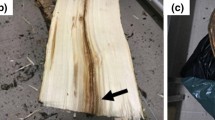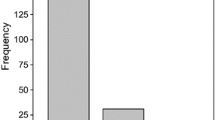Abstract
Changes in both vegetation and population and distribution of Phytophthora cinnamomi were monitored periodically between 1970 and 2000 on defined, infested quadrats and on similar pathogen-free quadrats on 13 sites representing major types of open eucalypt forest, woodland and heathland. The susceptible eucalypts in the overstorey of infested sites showed severe dieback, loss of crown or deaths. All trees died on some sites, trees at other sites presented dead leaders with epicormic growth on lower branches. Dieback of the heathy understorey, followed by death, occurred in 50–75% of the species, including the dominant Xanthorrhoea australis, thereby changing the community structure and the species composition. Species richness in infested quadrats declined, and percentage cover and percentage contribution to the community by susceptible species were almost eliminated. The ground remained bare on steep slopes, but on other sites the susceptible flora was replaced by fieId-resistant species of sedges and rushes, and by partly resistant teatrees (Leptospermum spp.) that formed a dense cover. The pathogen was isolated from 100% of the root samples from infested quadrats from 1970 to 1984, but isolation frequency then gradually declined. In 2000, P. cinnamomi was rare on six sites and not isolated from four. Regeneration of 30–40 susceptible species, previously eliminated from the quadrats, was recorded from infested quadrats and two thirds of these were growing on more than one quadrat. Substantial regeneration of the previously dominant but highly susceptible X. australis occurred at four sites. Crown recovery of the trees was not observed. It is not yet clear whether the regeneration of the understorey is stable, or whether successive cycles of disease and recovery will occur.
Similar content being viewed by others
References
Aberton MJ, Wilson BA, Cahill DM (1999) The use of potassium phosphonate to control Phytophthora cinnamomi in native vegetation at Angelsea, Victoria. Australasian Plant Pathology 28, 225–234.
Aberton MJ, Wilson BA, Hill J, Cahill DM (2001) Development of disease caused by Phytophthora cinnamomi in mature Xanthorrhoea australis. Australian Journal of Botany 49, 201–219.
Agrios GN (1997) ‘Plant pathology.’ (Academic Press: London)
Ali Z, Smith I, Guest DI 2000) Combinations of potassium phosphonate and Bion (acibenzolar-S-methyl) reduce root infection and dieback of Pinus radiata, Banksia integrifolia and Isopogon cuneatus caused by Phytophthora cinnamomi. Australasian Plant Pathology 29, 59–63.
Cahill DM, Wilson BA, Aberton MJ, Daniel R, Kemp J, Mohr P, Robinson L, Rookes J (2001) Unifying the responses of plants to Phytophthora—cellular controls. Proceedings of the Second Australasian Soilborne Diseases Symposium. (Eds IJ Porter et al.) pp. 29–30. (Department of Natural Resources and Environment: Victoria, Australia)
Cameron D, Cross F, Leech S, Wierzbowski P (1998) ‘Victorian flora species list.’ (Natural Resources and Environment)
Duncan MI, Keane PJ (1996) Vegetation changes associated with Phytophthora cinnamomi and its decline under Xanthorrhoea australis in Kinglake National Park, Victoria. Australian Journal of Botany 44, 355–369.
Gill AM, Ingwerson F (1976) Growth of Xanthorrhoea australis R.Br. in relation to fire. Journal of Applied Ecology 13, 185–203.
Hardham AR (2001) The cell biology behind Phytophthora pathogenicity. Australasian Plant Pathology 30, 91–98.
Hardy Guest, Barrett S, Shearer BL (2001) The future of phosphite as a fungicide to control soilborne plant pathogen Phytophthora cinnamomi in natural ecosystems. Australasian Plant Pathology 30, 130–139.
Kennedy J, Weste G (1977) Phytophthora cinnamomi in the Grampians. Australasian Plant Pathology Newsletter 6, 23–24.
Kennedy J, Weste G, (1986) Vegetation changes associated with invasion by Phytophthora cinnamomi on monitored sites in the Grampians, Western Victoria. Australian Journal of Botany 34, 251–279.
Peters D, Weste G (1997) The impact of Phytophthora cinnamomi on six rare native tree and shrub species in the Brisbane Ranges, Victoria. Australian Journal of Botany 45, 975–995.
Phillips D, Weste G (1984) Field resistance in three native monocotyledon species that colonise indigenous sclerophyll after invasion by Phytophthora cinnamomi. Australian Journal of Botany 32, 339–342.
Podger FD, Ashton DH (1970) Phytophthora cinnamomi in dying vegetation on the Brisbane Ranges, Victoria. Australian Forestry Research 4, 33–36.
Shearer BL, Dillon M (1996) Impact and disease centre characteristics of Phytophthora infestations of Banksia woodlands in the Swan Coastal Plain, Western Australia. Australian Journal of Botany 44, 79–90.
Walsh NG, Entwistle TJ (Eds) (1996) ‘Flora of Victoria Vol. 3.’ (Inkata Press)
Walsh NG, Entwistle TJ (Eds) (1999) ‘Flora of Victoria Vol. 4.’ (Inkata Press)
Weste G (1972) Phytophthora cinnamomi in native vegetation. Australian Plant Pathology Society Newsletter 1, 2–4.
Weste G (1974) Phytophthora cinnamomi the cause of severe disease in certain native communities in Victoria. Australian Journal of Botany 22, 1–8.
Weste G (1981) Changes in the vegetation of sclerophyll shrubby woodland associated with invasion by Phytophthora cinnamomi. Australian Journal of Botany 29, 261–276
Weste G (1986) Vegetation changes associated with invasion by Phytophthora cinnamomi of defined plots in the Brisbane Ranges, Victoria 1975–1987. Australian Journal of Botany 34, 633–648.
Weste G, Ashton DH (1994) Regeneration and survival of indigenous dry sclerophyll species in the Brisbane Ranges, Victoria, after a Phytophthora cinnamomi epidemic. Australian Journal of Botany 42, 239–253.
Weste G, Cooke D, Taylor P (1973) The invasion of native forest by Phytophthora cinnamomi. 11. Postinfection patterns, regeneration, decline in inoculum and attempted control. Australian Journal of Botany 2, 13–29.
Weste G, Kennedy J (1997) Regeneration of susceptible native species following a decline of Phytophthora cinnamomi over a period of 20 years on defined plots in the Grampians, Western Victoria. Australian Journal of Botany 45, 167–190.
Weste G, Law C (1973) The invasion of native forest by Phytophthora cinnamomi. 111. Threat to the National Park, Wilsons Promontory, Victoria. Australian Journal of Botany 21, 31–51.
Weste G, Ruppin P (1977) Phytophthora cinnamomi population densities in forest soils. Australian Journal of Botany 25, 461–475.
Weste G, Taylor P (1971) The invasion of native forest by Phytophthora cinnamomi. 1. Brisbane Ranges, Victoria. Australian Journal of Botany 19, 281–294.
Weste G, Vithanage K (1978) Effect of Phytophthora cinnamomi on microbial populations associated with the roots of forest flora. Australian Journal of Botany 26, 153–167.
Weste G, Vithanage K (1979) Production of sporangia by Phytophthora cinnamomi in forest soils. Australian Journal of Botany 26, 698–702.
Weste G, Walchhuetter T, Walche T (1999) Regeneration of Xanthorrhoea australis following epidemic disease due to Phytophthora cinnamomi in the Brisbane Ranges, Victoria. Australasian Plant Pathology 28, 162–169.
Author information
Authors and Affiliations
Corresponding author
Rights and permissions
About this article
Cite this article
Weste, G. The dieback cycle in Victorian forests: a 30-year study of changes caused by Phytophthora cinnamomi in Victorian open forests, woodlands and heathlands. Australasian Plant Pathology 32, 247–256 (2003). https://doi.org/10.1071/AP03013
Received:
Accepted:
Issue Date:
DOI: https://doi.org/10.1071/AP03013




